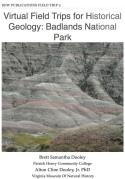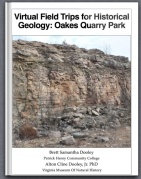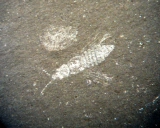 As the blog has evolved over the years, one of the things I have done to try to make it more interesting and more representative of paleontology as a career is the daily updates from my excavations. My hope has been that this would enable people to follow along on our digs, a kind of “next best thing to being there.”
As the blog has evolved over the years, one of the things I have done to try to make it more interesting and more representative of paleontology as a career is the daily updates from my excavations. My hope has been that this would enable people to follow along on our digs, a kind of “next best thing to being there.”
There are certain challenges in writing this way, with one of the most obvious being that after a long day in the field I’m often up in my hotel room until midnight composing that day’s entry. Another significant risk is that it provides me with lots of opportunities to look like an idiot, particularly when I’m trying to make identifications without a library or my collections at hand.
Last week, I reported both here and on my Twitter feed that during the excavation John Parker had found a possible land mammal bone, most likely the distal end of the humerus (the elbow-end of the upper arm). Concerned about damaging the specimen, I wisely decided to wait until I returned to the museum to completely clean the sediment from it. Once cleaned, it became clear that the bone had a very lightweight internal structure (above). Was it possible that this was a bird rather than a land mammal? I had briefly considered this possibility in the field, but thought it much less likely than a land mammal.
Once the bone was clean, I took it down to hall to show to our archaeologist, Elizabeth Moore. Zooarchaeologists are very good at identifying tiny scraps of bone from human sites, and often I can use that material to get me at least to the right family when doing an identification. We agreed that this was the distal end of a right humerus, and while comparing it to domestic mammals Elizabeth independently suggested that it looked a lot like a bird, except for the huge size. We pulled a goose humerus from her collection for comparison:
 This wasn’t an exact match, but it’s pretty close considering that these aren’t even in the same family. This was the humerus from a huge bird – note that the end of the humerus is about 2.5 times wider than that of the goose, which isn’t exactly a small bird!
This wasn’t an exact match, but it’s pretty close considering that these aren’t even in the same family. This was the humerus from a huge bird – note that the end of the humerus is about 2.5 times wider than that of the goose, which isn’t exactly a small bird!
What kind of bird could there be in the Calvert Formation with such a gigantic humerus? As it turns out, I had already blogged about one over two years ago; the giant pelagornithid Pelagornis. This is the first pelagornithid ever found at Carmel Church.
We already had a single pelagornithid (or pseudodontorn, to use an older term) bone in the VMNH collection, a fragment of the proximal end of the right humerus. (If you go back to the old post, you’ll see I said it’s a left humerus. That’s another error; I was basing that on the mislabeled specimen in Olson and Rasmussen, 2001. The error was pointed out in Mayr and Rubilar-Rogers, 2010.) This specimen is from Hanover County, VA, not Carmel Church, but it is from Bed 14 or 15 of the Calvert Formation so it’s about the same age as the Carmel Church specimen. We can lay them both next to the goose humerus for comparison (note that only half of the proximal end is preserved, so it should be about twice as wide):
 This doesn’t really do the comparison justice, however, because we don’t know the shaft length for the bone. Fortunately a recent paper by Mayr and Rubilar-Rogers (2010) described the largely complete skeleton of a new species of Pelagornis, P. chilensis from Miocene-Pliocene of Chile. My quick estimates suggest that P. chilensis was about the same size or a little larger than the Calvert specimens, so we can use the P. chilensis humeral length of 82 cm (!) as a rough guess for the Calvert pelagornithid (again with the goose for comparison):
This doesn’t really do the comparison justice, however, because we don’t know the shaft length for the bone. Fortunately a recent paper by Mayr and Rubilar-Rogers (2010) described the largely complete skeleton of a new species of Pelagornis, P. chilensis from Miocene-Pliocene of Chile. My quick estimates suggest that P. chilensis was about the same size or a little larger than the Calvert specimens, so we can use the P. chilensis humeral length of 82 cm (!) as a rough guess for the Calvert pelagornithid (again with the goose for comparison):
 Mayr and Rubilar-Rogers estimate that P. chilensis had a wingspan of 5.25 to 6.1 m, making this one of the largest flying birds of all time (the teratorn Argentavis may have been larger, but Mayr and Rubilar-Rogers point out that that specimen is much less complete with greater uncertainties in the estimates). So we can add birds with wingspans approaching 20 feet to our growing picture of Carmel Church during the middle Miocene.
Mayr and Rubilar-Rogers estimate that P. chilensis had a wingspan of 5.25 to 6.1 m, making this one of the largest flying birds of all time (the teratorn Argentavis may have been larger, but Mayr and Rubilar-Rogers point out that that specimen is much less complete with greater uncertainties in the estimates). So we can add birds with wingspans approaching 20 feet to our growing picture of Carmel Church during the middle Miocene.
References:
Olson, S. L. and P. C. Rasmussen, 2001. Miocene and Pliocene birds from the Lee Creek Mine, North Carolina, in C. E. Ray and D. J. Bohaska, eds., Geology and Paleontology of the Lee Creek Mine, North Carolina, III. Smithsonian Contributions to Paleontology No. 90, p. 233-365. (pdf)
Mayr, G. and D. Rubilar-Rogers, 2010. Osteology of a new giant bony-toothed bird from the Miocene of Chile, with a revision of the taxonomy of Neogene Pelagornithidae. Journal of Vertebrate Paleontology 30:1313-1330. (JVP link)
I’d like to thank all the excavators we had last week that made this such a successful trip: Brett, Tim, Laura, Jordan, John, Christina, DB, Joe, and Paul. In addition to the nice specimens we recovered, the Washington Post also came by the site to do a story and video on the excavation.










It looks like iPads and iPhones are having trouble loading the embedded video from Washington Post, but it seems to work fine from a computer. i-devices can view the video at the linked site, however.
More coverage of the excavation, from Roanoke College:
http://roanoke.edu/News_and_Events/Campus_News/Spring_break_dig_in_Washington_Post.htm
Hey Butch,
I’m on spring break and have been a little too busy (thus far) to comment much – but I did think there was something pelagornithid-ish in that bone. Of course, I’ve only found a proximal end and haven’t paid much attention to distal humeri – but then again, some authors have misidentified proximal humeri as distal humeri anyway.
I’ve got a paper coming out in JVP soon on a Pliocene Pelagornis humerus from he Purisima Formation.
I’ve had a hard time finding images of the distal end of the humerus in pelagornithids. In P. chilensis the distal end is missing on one side and poorly preserved on the other, and there’s no included figure of closeups of the ends of the long bones anyway. It seems that the Lee Creek and Pamunkey River humeri all include the proximal ends only, which is also true of our Hanover County specimen.
I’ve been slowly working on a manuscript on Carmel Church birds; we’ve got a dozen or so specimens now, representing 3-4 different taxa. Finding a pelagornithid might finally spur me into finishing the paper and getting it submitted.
I’m glad to hear you’ve got one from the Purisima; I’m looking forward to that paper.
that is an awesome video.
wish I could have been there in the mud with you all.
I know it was cold and nasty, but it is still fun 🙂
See ya on the next go round at the site.